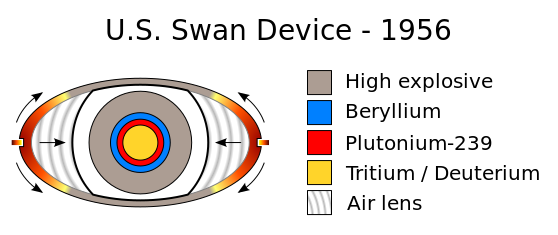
Nuclear weapon designs are physical, chemical, and engineering arrangements that cause the physics package of a nuclear weapon to detonate. There are three existing basic design types:
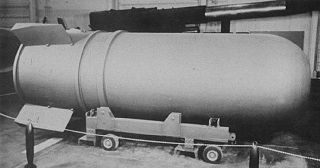
The B-41 was a thermonuclear weapon deployed by the United States Strategic Air Command in the early 1960s. It was the most powerful nuclear bomb ever developed by the United States, with a maximum yield of 25 megatons of TNT. A top secret document, states “The US has stockpiled bombs of 9 MT and 23 MT...” which would likely be referring to the B-41's actual yield(s). The B-41 was the only three-stage thermonuclear weapon fielded by the U.S.
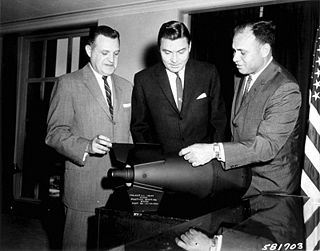
The W54 was a tactical nuclear warhead developed by the United States in the late 1950s. The weapon is notable for being the smallest nuclear weapon in both weight and yield to have entered US service. It was a compact implosion device containing plutonium-239 as its fissile material, and in its various versions and mods it had a yield of 10 to 1,000 tons of TNT.

Medium Atomic Demolition Munition (MADM) was a tactical nuclear weapon developed by the United States during the Cold War. It was an atomic demolition munition (ADM), a combat engineering device for demolition of structures and for battlefield shaping. The device contained a W45 warhead with an estimated yield of 0.5 to 15 kilotonnes of TNT. Each MADM weighed 391 pounds (177 kg) in its transportation container. They were deployed between 1962 and 1986.

The W48 was an American nuclear artillery shell, capable of being fired from any standard 155-millimetre (6.1 in) howitzer. A tactical nuclear weapon, it was manufactured starting in 1963, and all units were retired in 1992. It was known as the XM454 AFAP in US service.
The W52 was a thermonuclear warhead developed for the MGM-29 Sergeant short-range ballistic missile used by the United States Army from 1962 to 1977. The W52 was 24 inches (61 cm) in diameter and 57 inches (140 cm) long, and weighed 950 pounds (430 kg). It had a yield of 200 kilotons. A total of 300 W52 warheads were produced.

The W49 was an American thermonuclear warhead, used on the Thor, Atlas, Jupiter, and Titan I ballistic missile systems. W49 warheads were manufactured starting in 1958 and were in service until 1965, with a few warheads being retained until 1975.
The B46 nuclear bomb was an American high-yield thermonuclear bomb which was designed and tested in the late 1950s. It was never deployed. Though originally intended to be a production design, the B46 ended up being only an intermediate prototype of the B-53 and was test fired several times. These prototypes were known as TX-46 units (Test/Experimental).
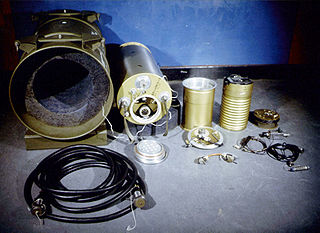
The W45 was a multipurpose American nuclear warhead developed in the early 1960s, first built in 1962 and fielded in some applications until 1988. It had a diameter of 11.5 inches (290 mm), a length of 27 inches (690 mm) and weighed 150 pounds (68 kg). The yields of different W45 versions were 0.5, 1, 5, 8, 10, and 15 kilotons. The W45 was designed at the Livermore branch of the University of California Radiation Laboratory (UCRL), now Lawrence Livermore National Laboratory.

The W56 was an American thermonuclear warhead produced starting in 1963 which saw service until 1993, on the Minuteman I and II ICBMs.

The Mark 39 nuclear bomb and W39 nuclear warhead were versions of an American thermonuclear weapon, which were in service from 1957 to 1966.
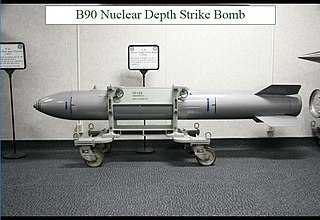
The B90 Nuclear Depth Strike Bomb (NDSB) was an American thermonuclear bomb designed at Lawrence Livermore National Labs in the mid-to-late 1980s and cancelled prior to introduction into military service due to the end of the Cold War.

The W31 was an American nuclear warhead used for two US missiles and as an atomic demolition munition.
The W30 was an American nuclear warhead used on the RIM-8 Talos surface-to-air missile and the Tactical Atomic Demolition Munition (TADM).
The Mark 27 nuclear bomb and closely related W27 warhead were two American thermonuclear bomb designs from the late 1950s.
Kinglet was a boosted fission primary used in several American thermonuclear weapons.
The Mark 24 nuclear bomb was an American thermonuclear bomb design, based on the third American thermonuclear bomb test, Castle Yankee. The Mark 24 bomb was tied as the largest weight and size nuclear bomb ever deployed by the United States, with the same size and weight as the Mark 17 nuclear bomb which used a very similar design concept but unenriched Lithium.

The Mark 15 nuclear bomb, or Mk-15, was a 1950s American thermonuclear bomb, the first relatively lightweight thermonuclear bomb created by the United States.
The Mark 13 nuclear bomb and its variant, the W-13 nuclear warhead, were experimental nuclear weapons developed by the United States from 1951 to 1954. The Mark 13 design was based on the earlier Mark 6 nuclear bomb design, which was in turn based on the Mark 4 nuclear bomb and the Mark 3 nuclear bomb used at the end of World War II.

The uranium hydride bomb was a variant design of the atomic bomb first suggested by Robert Oppenheimer in 1939 and advocated and tested by Edward Teller. It used deuterium, an isotope of hydrogen, as a neutron moderator in a uranium-deuterium ceramic compact. Unlike all other fission-based weapon types, the concept relies on a chain reaction of slow nuclear fission. Bomb efficiency was adversely affected by the cooling of neutrons since the latter delays the reaction, as delineated by Rob Serber in his 1992 extension of the original Los Alamos Primer.
